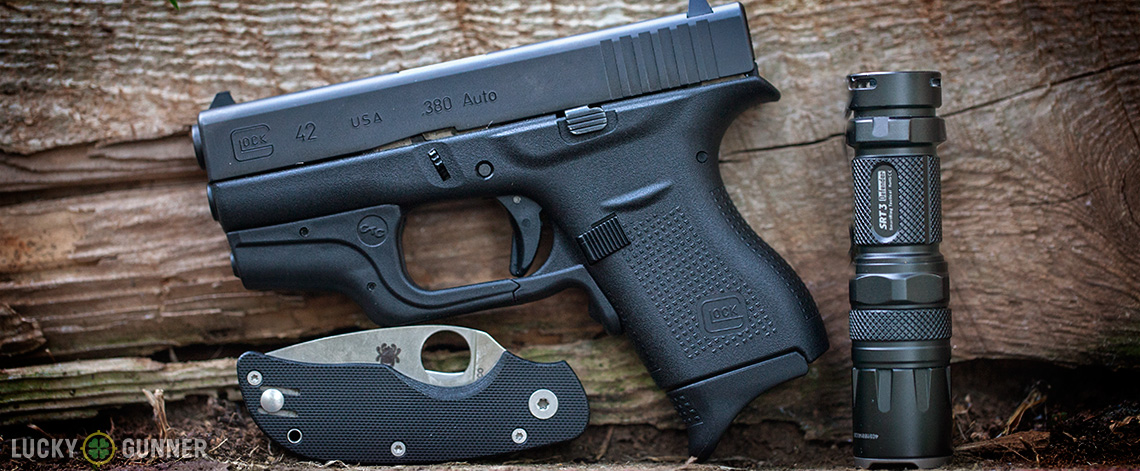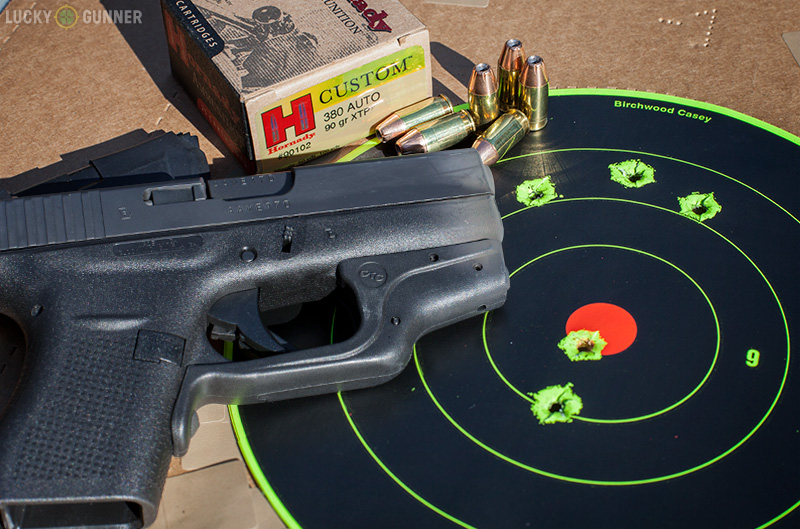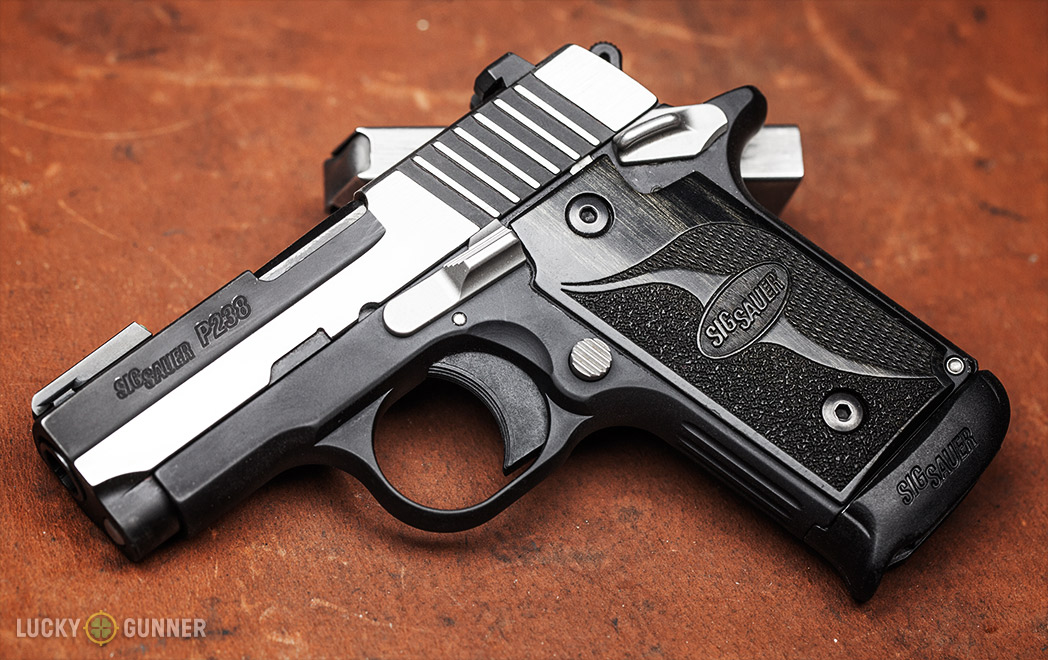Prior to 2014, Glock had not released a new pistol design since the beginning of the century. There were a few old Glock designs rechambered for new calibers, and we got the updated Gen 4 Glocks, but the last pistol the Austrian company produced that could truly be considered a new design was the single stack .45 ACP Glock 36, which became available in 2000.
There have been a lot of rumors and wishful thinking about what Glock’s next new design would be, but it was a long 14 years before the company said anything official. Toward the end of last year, Glock ads hinted at a new concealed carry offering that many people assumed was the long awaited Glock single stack 9mm.
It wasn’t. The Glock 42 turned out to be a .380 ACP instead, and compared to the competition, a large one. The initial reaction was, to put it politely, lukewarm. Before anyone even had a chance to try the new pistol, Glock was already taking heat because it came in the wrong caliber.
First Impressions of the Glock 42
Here we are nearly a year later and just about every blogger, magazine writer, and YouTube channel in the gun world has thrown in their two cents on the Glock 42. That initial backlash did eventually cool off, and the shooting community has had a chance to evaluate the Glock 42 for what it is, rather than for what we hoped it would be.
Since re-hashing the technical specs and features of this pistol isn’t exactly breaking news at this point, I’m going to save the usual routine review description stuff for the end and cut right to my own take on the Glock 42.

My first experience with the new Glock was at SHOT Show this past January. I was permitted to fire one whole magazine from the demo gun, which isn’t much to work with for a first impression. But it was enough for me to get a pretty clear picture of what Glock was going for, which I wrote about in the Glock 42 SHOT Show mini-review. Instead of making the smallest .380 ACP on the market, it seems that Glock decided to instead make one that would actually be easy to shoot.
Testing the Glock 42
In September, I finally picked up a Glock 42 to do an actual review, and in the 500 or so rounds I’ve fired since then, that initial impression from SHOT Show hasn’t really changed much. It is noticeably larger than the ultra-compact pocket .380 pistols that have been so popular the last few years, but I think it might be the smallest and lightest centerfire pistol that I could comfortably shoot all day.
Despite some complaints about the G42’s size, it’s still smaller than the vast majority of the next largest category of carry pistols — the sub-compact single stack 9x19mm semi-autos like the Beretta Nano or S&W Shield. During one of the range sessions for our epic 9mm carry gun comparison test, I brought along the Glock 42 to see how it would measure up. I’m a big fan of the small nines, but their somewhat snappy recoil does take some effort and practice to learn to control under rapid fire. Not surprisingly, shooters who don’t make it to the range regularly seem to have a tough time getting quick follow-up shots on target with these guns.
After getting the hang of one of those little 9mm’s, switching over to the Glock 42 feels like cheating. With almost no effort at all, the front sight simply snaps back onto target after each shot. If all centerfire handgun calibers were equally effective for self-defense, the favorable combination of small size and light recoil found in the Glock 42 would instantly render obsolete dozens of other carry guns that are either more difficult to shoot or more difficult to carry.
Obligatory .380 ACP Caliber Disclaimer
But all handgun calibers are not equally effective, and .380 ACP is at the lower end of the curve. Unfortunately, the hypothetical continuum of effectiveness is not really something we can quantify. However, by every indication, .380 ACP rounds are less likely to stop an attacker, even with multiple hits, compared to the common service calibers like 9mm, .40 S&W, or .45 ACP. If you’re going to trust your life to something smaller, there has to be a pretty compelling reason for not choosing one of the “real” calibers. That in itself is reason enough for many folks to dismiss the Glock 42 as a serious self-defense tool.
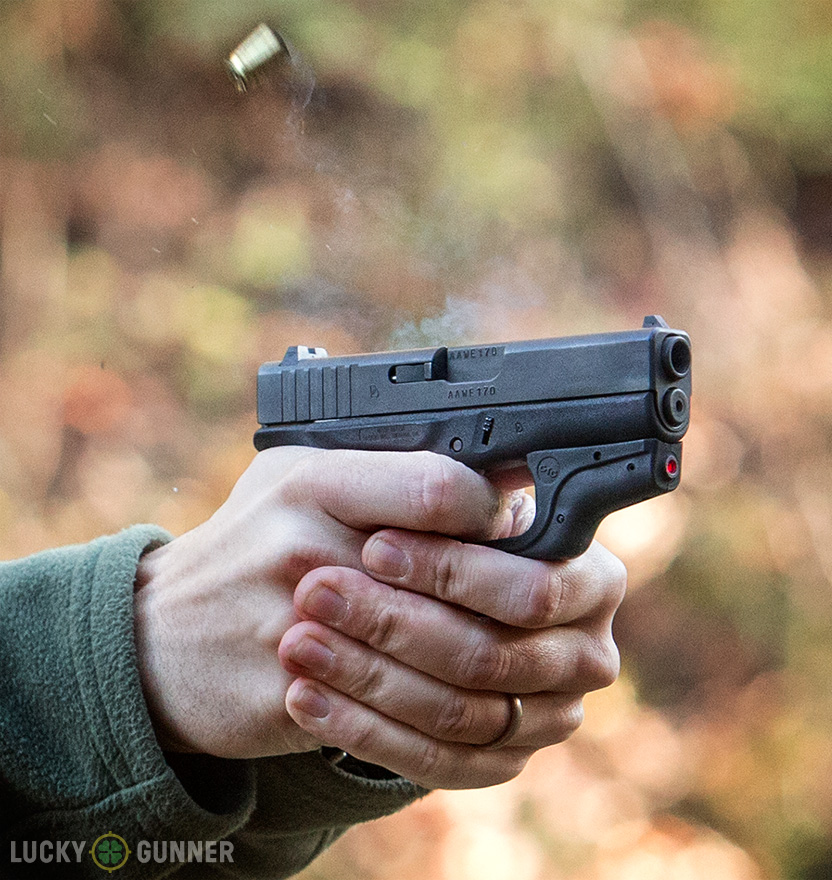
The .380 ACP caliber has seen a huge surge in popularity in the last few years not because it is particularly effective, but because it’s the most effective cartridge that can fit into a diminutive carry gun like the popular Ruger LCP. If the only reason to carry a .380 is so you can carry the smallest gun possible, it’s not so hard to understand why the first reactions to the Glock 42 were criticisms about its slightly larger size.
But at the same time, the concealed carry market as a whole is beginning to realize that a sub-10 ounce gun is really tough to shoot. And as I mentioned above, even a 16 ounce single stack 9mm can also be quite a handful for most casual shooters. Pistols like the Glock 42 fill the gap. Yes, it’s throwing some pretty small bullets at unimpressive velocities, but it’s doing that from a gun that most shooters can learn to shoot competently in a fraction of the time it would take to train someone to control the recoil and muzzle flip of a pocket 9mm or a snub nosed .38 special.
Recommendation
Ideally, I wouldn’t suggest the Glock 42 (or any other .380 ACP for that matter) to anyone as the first choice for concealed carry. But what’s ideal isn’t reality.
We all know that most people with carry permits don’t practice very often and they tend to put as little effort as possible into concealment and holster selection. Stiff recoil only makes them less eager to practice and a bigger gun makes them less likely to carry at all. The Glock 42 is a good compromise for someone who has enough shooting experience to carry a gun competently and safely, but who probably won’t make it out to the range very often.*
But I don’t want to give the impression that I think the Glock 42 is only a gun for newbies. Despite carrying a double stack 9mm most of the time, there are occasions when I find it to be a hindrance, and carrying a smaller gun makes life much easier. For example, if I go for a run in the neighborhood or do some yard work, I’ll often carry a Ruger LCR loaded up with five .38 Special +P hollow points.
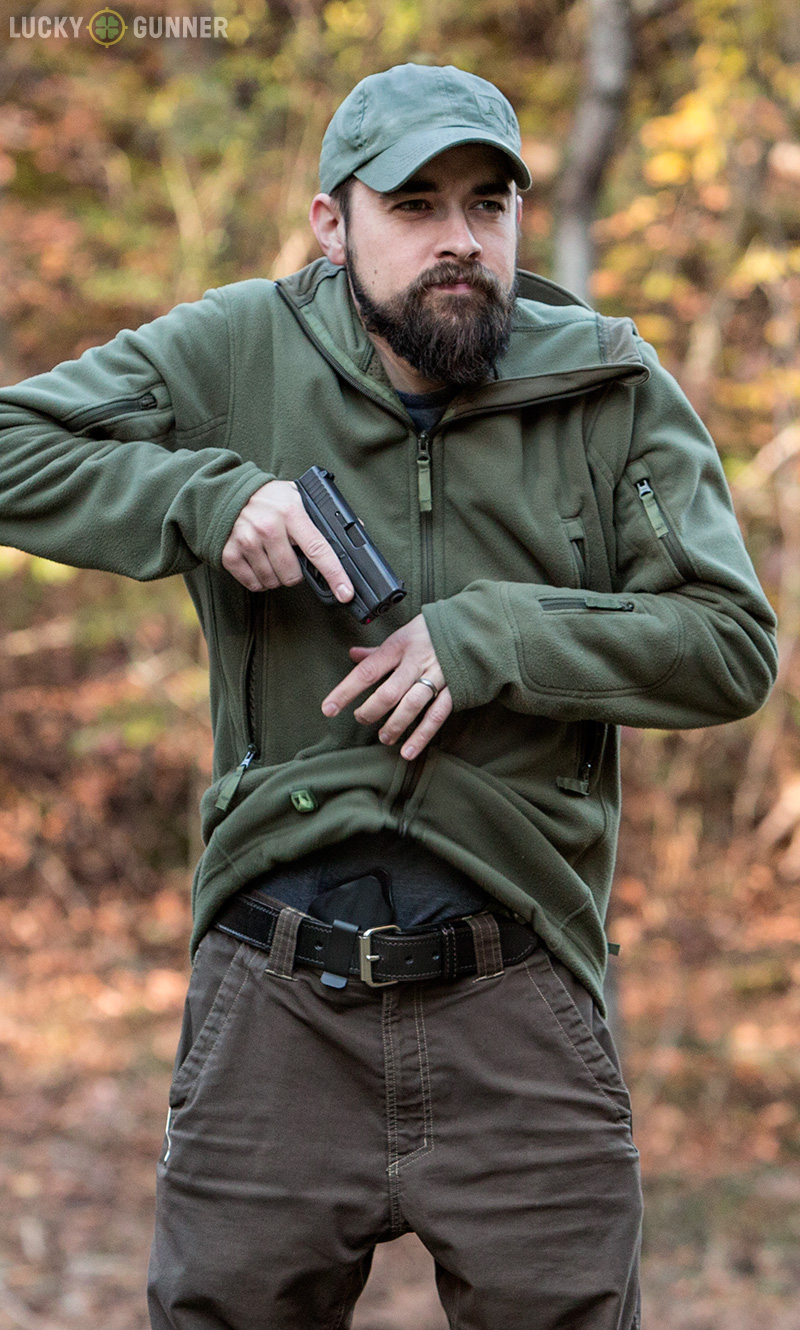
Unfortunately, I haven’t had much trigger time with revolvers this year, and the last time I took the LCR to the range, it was clear that my ability with the double action trigger is not what it used to be. The Glock 42 on the other hand, is just as comfortable to carry, but is more like a junior-size version of the striker fired pistols I shoot on a regular basis. It doesn’t have the same punch as my other carry guns, but I have complete confidence that I can group 7 quick rounds into the center mass of anything within spitting distance.
Most of the guns we review here on the Lounge are either borrowed from friends, purchased specifically for the review, or sometimes loaned to us by the firearm companies. They are typically re-sold or returned once the review is complete, but this time, I think I’ll be coughing up the cash from my own pocket to keep the Glock 42. It’ll serve as a second option for those times when the M&P9c I normally carry is too bulky. I hate to be cliché, but the Glock 42 “just works.”
* – Notice that I didn’t single out “beginners, women, the elderly, and small statured people”, although many of these folks could benefit from the ease of use the Glock 42 offers. I’ve also seen strong 250 pound adult men who are lifelong gun owners but can’t hit an 8-inch paper plate at 5 yards twice in a row with a full size 9mm unless they stop to adjust their stance and grip in between every shot. Some baseline training and competency is required, even with a pistol as shootable as the Glock 42.
Usability Notes
As I mentioned at the beginning, the details and features of the Glock 42 have been reported by numerous other sources, but here are a few of my own observations.
Trigger
The Glock 42 supposedly has the same type of trigger as every other pistol that comes out of the Glock factory, but I think that’s more of a variable than the company implies. Glock’s website claims the G42’s trigger breaks at 5.5 pounds, which is pretty close to what others have reported. On a trigger scale, the Glock 42 I tested averaged 8.5 pounds, and that’s after a generous 400-round “break-in” period.
In addition to being much heavier than advertised, it’s pretty heavy for any striker fired pistol. It’s the most disappointing aspect of this gun for me, but a heavy Glock trigger is still a big improvement over the type double action trigger often found on other carry pistols.
Aftermarket Support
As with any of Glock’s offerings, there are numerous aftermarket offerings for the Glock 42. This is an often overlooked advantage when choosing a carry gun. Popular guns always have more available holsters, sight options, and other accessories that might be difficult to find with more obscure pistols.
Reliability
Most of the shooting done for the review was with Remington UMC 95 grain FMJ. The Glock 42 ran through roughly 450 rounds of that with almost no issue. There was a single failure and I’m almost certain it was shooter-induced. I was helping out a fairly inexperienced shooter, who happens to be a petite female and who also happens to be my mom. She was mostly interested in shooting .22 LR that day, but wanted to try running a magazine through the Glock 42 before we left the range.
On her first round, the gun experienced a double feed malfunction. I helped her clear it and suggested she squeeze the grip as tightly as possible. She fired the rest of the magazine with no problem, and I suspect that the failure was caused by the infamous “limp-wristing” that many of the small semi-autos are prone to.
Otherwise, the Glock 42 didn’t hiccup again with the Remington ammo or any of the assorted loads that were used for accuracy testing.
Ergonomics
I found the Glock 42 to have a really comfortable grip, especially for a pistol this small. It’s got a decent amount of texturing, and a deep recess for the web of the shooting hand to get a high grip.
Like most small guns, my pinky didn’t have anything to hang onto, which for me, makes the gun much harder to shoot well. A couple of Pearce grip extensions installed on the Glock factory magazines fixed the problem right away.
Ease of Use
There’s not much to say here because the G42, like all Glock pistols, has no extraneous controls or safeties to talk about. It doesn’t seem like a big deal, but how many other ultra-concealable carry guns are so simple to operate? Most either have a long, heavy double action trigger, a tiny and difficult to use manual safety, or both.
Whether you generally like Glock pistols or not, it’s easy to appreciate their simplicity of operation and consistency from one model to the next.
Glock 42 Technical Specs
| Barrel Length | 3.25″ |
| Overall Length | 5.54″ |
| Height | 4.13″ |
| Width | .94″ |
| Weight (unloaded) | .86 lbs. |
| Sights | Glock white “cup and ball” style |
| Action | Striker-fired single-action |
| External Safety | Two-piece trigger safety |
| Ammo Capacity | 6+1 |
| Measured trigger pull weight | 8.5 lbs |
| Included Accessories | Two magazines |
| MSRP | $480 |
Accuracy
I grabbed a few different .380 loads and tested accuracy from a sandbag rest at 25 yards. At this distance, it became clear the factory sights were misaligned, and shots were falling a few inches below and to the left of the target. I zeroed the Crimson Trace laser to bring the hits into the black, and used that for the accuracy testing instead. You don’t typically think of guns this small being able to hit much at anything past a few yards, but with the right ammo, the Glock 42 shot some decent groups.
| Ammo | 25 Yard Group Size |
| Hornady XTP 90 gr | 3.55″ |
| Magtech JHP 95 gr | 6.44″ |
| Winchester Silvertip 85 gr | 3.58″ |
| Blazer Brass FMJ 95 gr | 5.17″ |
The Competition
For many people, this is the elephant in the room that I’ve been avoiding up to this point. The Glock 42 is not the only carry pistol available that’s both small and soft on recoil. In that regard, I think the Glock has two major competitors; the Ruger LC380 and the Sig P238.
The LC380 is essentially a Ruger LC9 that’s been converted from 9mm to .380 ACP. It’s a hair bigger than the Glock 42, but looks like a giant next to it’s little brother, the Ruger LCP. For the budget-concious, the LC380 is about $100-150 less than the Glock, and at the price point, it’s a pretty good deal. It has very managable recoil, but unfortunately it’s plagued with the same looooong double action trigger as the LC9. It can certainly be mastered, but compared to the Glock 42, it’s not a gun that as many people will intuitively be able to shoot well.
If I were in the market for a concealable .380 and the Glock was out of my price range, I’d wait to see if Ruger comes out with a striker fired version of the LC380 like they recently did for the LC9. The new LC9s has a much improved trigger over the original LC9, so keep an eye out for a LC380s in the future.
The Sig P238 is on the opposite end of the market from the LC380. It has a great trigger, it’s smaller than the Glock 42, and costs about twice as much as the Ruger. If you have the cash for a P238, it might be difficult to see the appeal of the Glock.
I owned a P238 for a while, and even though I found it to have shockingly little recoil for its size, shooting it was problematic. It’s so small, that I found it almost impossible to get a grip that didn’t interfere with the slide stop lever in some way that would cause premature slide lock. The placement of the safety also made it difficult to disengage during the draw stroke.
Folks with smaller hands might have an easier time finding a good grip, but still might struggle with the the controls becoming second-nature unless they’re already experienced with single action pistols. I can definitely understand the appeal of the P238, but the simplicity of the Glock’s controls makes more sense to me on a gun of this size.
If you’ve picked up a Glock 42 this year, let us know why you chose it and what you think of it so far.
